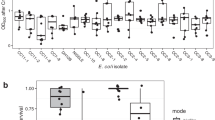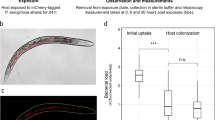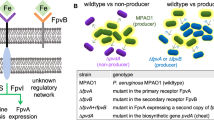Abstract
The virulence of pathogenic microbes can depend on individual cells cooperating in the concerted production of molecules that facilitate host colonization or exploitation. However, cooperating groups can be exploited by social defectors or ‘cheats’. Understanding the ecology and evolution of cooperation is therefore relevant to clinical microbiology. We studied two genetically linked cooperative traits involved in host exploitation by the opportunistic human pathogen Pseudomonas aeruginosa. Clones that defected from cooperative production of iron-scavenging siderophores were deficient in biofilm formation. The presence of such clones in mixed biofilms with a wild-type clone led to reduced biofilm mass. The fitness advantage of siderophore-deficient mutants in the presence of wild-type bacteria was no greater in biofilm than in planktonic culture, suggesting that these mutants did not gain an additional advantage by exploiting wild-type biofilm polymer. Reduced biofilm formation therefore represents a pleiotropic cost of defection from siderophore production.
Similar content being viewed by others
Main
Bacteria cooperate in numerous ways, including public goods production, food scavenging and niche provision (West et al., 2006). Cooperative traits can be linked by correlated expression or by their effects (Velicer, 2003; Banin et al., 2005; Juhas et al., 2005). Understanding selective pressures on cooperation is therefore likely to require consideration of multiple traits simultaneously. We investigated two clinically relevant cooperative traits: production of iron-scavenging siderophores (Griffin et al., 2004; Harrison et al., 2006) and biofilm formation (Costerton et al., 2003; Brockhurst et al., 2006; Moreau-Marquis et al., 2008). Both can be exploited by ‘cheats’: cells that cease producing costly public goods (siderophores or biofilm matrix polymers) but benefit from the efforts of their neighbours. Cheats decrease total public good availability and hence population growth (Griffin et al., 2004; Brockhurst et al., 2006), potentially causing reduced virulence (Harrison et al., 2006).
In Pseudomonas aeruginosa, biofilm formation requires iron (Singh et al., 2002) and siderophore-deficient mutants show a pleiotropic reduction in biofilm-forming ability (Banin et al., 2005). This could impose an additional cost on mutants with reduced siderophore production. However, siderophore-deficient mutants might be ‘supercheats’ within biofilms, exploiting two public goods whereas paying the costs of neither. If so, siderophore-deficient cells should not only invade cooperator biofilms, but also enjoy a greater growth advantage in biofilms than under planktonic growth.
To investigate this hypothesis, we grew biofilms using six siderophore-deficient clones, singly and in combination with the wild-type (cooperator) strain PA01. One clone was an isogenic transposon-bearing PA01 mutant (Jacobs et al., 2003) with an insertion in pvdF, a gene required for synthesis of the primary siderophore pyoverdine (Visca et al., 2007). The remaining clones evolved from the methionine auxotroph PA06049 (a transposon mutant of PA01: Rella et al., 1985)) under selection for siderophore cheats (Harrison and Buckling, 2005; Supplementary information). Biofilms were grown using a microplate/peg lid system (Moskowitz et al., 2004), in iron-limited or iron-supplemented medium (Full methods in Supplementary information).
Although biofilm formation by the pvdF mutant was enhanced by iron supplementation (P=0.004; Figure 1b), the mutant had lower total biofilm mass than its ancestor PA01 in both iron regimes (t-tests, P<0.001; Figure 1; Supplementary Figure S1). This is consistent with previous results (Banin et al., 2005). In contrast, planktonic growth of the mutant was reduced relative to PA01 only under iron limitation (iron-limited P=0.01, iron-supplemented P=0.727; Supplementary Figure S2). This demonstrates a greater cost to siderophore deficiency in biofilms relative to planktonic cultures. Further, in mixed culture the mutant reached lower frequencies in biofilm than in plankton (Wilcoxon signed-rank test, P=0.014; Figure 2). Mixed cultures produced biofilms of a comparable mass to pure pvdF cultures (t-test, P=0.38; Figure 1), which was less than expected, given the proportions of wild-type and pvdF cells present (t-test, P<0.001). As decreased biofilm mass presumably has disadvantages in isolation, but confers no additional cheating benefit in the presence of the wild type, this probably represents a pleiotropic fitness cost of siderophore cheating. The mutant is certainly not a ‘supercheat’.
(a) Single-strain and mixed-strain biofilm mass in iron-limited growth medium. y Axis shows A590 of crystal violet-stained biofilms. White bars represent single-strain biofilms and grey bars represent PA01+cheat mixtures; bars show mean±standard error of the mean (N=10 in each case). Pure cheat biofilms had lower mass than pure ancestral wild-type biofilms (pvdF versus PA01, T15=7.08, P<0.001; clones 1–5 versus PA06049, T⩾7.39, P<0.001). Mixed PA01+siderophore mutant cultures produced less biofilm than pure PA01 cultures (T⩾5.05, P<0.001). (b) Ratios of biofilm mass in iron-limited versus iron-supplemented growth medium for strains grown singly. y Axis shows A590 of crystal violet-stained iron-limited biofilms/A590 of crystal violet-stained iron-supplemented biofilms; bars show mean±standard error of the mean (N=10 in each case). Ratios were <1 for siderophore-deficient clones (T⩾2.81, P⩽0.010) but >1 for wild types (PA01 T9=3.88, P=0.002, PA06049 T9=4.34, P=0.001).
Box plots showing frequencies of siderophore-deficient clones recovered from PA01 and PA01+cheat biofilm (grey boxes) and planktonic (white boxes) subpopulations in iron-limited growth medium. Boxes show median, 10th, 25th, 75th and 90th percentile, crosses show mean. For pure PA01 and PA01+evolved clone mixtures, siderophore-deficient cells reached comparable frequencies in biofilm and planktonic subpopulations (Wilcoxon signed-rank tests, P⩾0.25). In PA01+pvdF populations, cells of the pvdF mutant reached lower frequencies in biofilm (P=0.014), though this was not significant once α was corrected for false discovery rate.
PA06049 produced a comparable level of biofilm to PA01 when iron was limiting (t-tests, P>0.9). All five evolved clones produced less biofilm than PA06049 under iron limitation (t-tests, P<0.001) and under iron supplementation (t-tests, P⩽0.021). Iron limitation reduced biofilm formation by siderophore-deficient clones (t-tests, P<0.02). This supports the link between siderophores, iron and biofilms in clones that could carry mutations in traits other than siderophore production. In contrast with the pvdF mutant, these results cannot be explained by poor growth of mutants in iron-limited medium: whereas one mutant showed reduced planktonic growth relative to PA06049 (clone 2, P=0.003), one showed increased growth (clone 3, P=0.002) and the remainder showed similar growth to PA06049 (P>0.4) (Supplementary Figure S2). This apparently contradicts findings that siderophore deficiency decreases iron-limited monoculture growth (Griffin et al., 2004). However, our clones had adapted to laboratory conditions for approximately 200 generations and other, growth-enhancing, mutations would have outweighed the costs of reduced siderophore production.
Mixed PA01+evolved clone cultures produced less biofilm than pure PA01 cultures in all but one case (Figure 1a; Supplementary Figure S1; t-tests, P<0.001 except iron-supplemented PA01+clone 5 P=0.351). Iron-limited mixtures formed biofilms whose mass did not differ from that expected given the proportions of wild-type and siderophore-deficient cells present (t-tests, P⩾0.369), except for PA01+clone 3, which formed less biofilm than expected (P<0.001).
Under iron limitation, evolved siderophore cheats did not gain an additional advantage in biofilm: in no case did the frequency of cheats recovered from the biofilm and liquid subpopulations differ (Figure 2, Wilcoxon signed-rank tests, P⩾0.25). Moreover, although siderophore-deficient clones appeared de novo in pure PA01 populations, their biofilm and planktonic frequencies did not differ (P=0.299). Like the pvdF mutant, these clones are not ‘supercheats’, and biofilm deficiency represents a pleiotropic fitness cost of siderophore cheating. Pleiotropic costs of cheating are known (Foster et al., 2004), but we are unaware of any other report that cheating incurs a cost by disrupting another social trait.
Defective biofilms could impose a severe fitness cost on siderophore-deficient subpopulations. Rare siderophore-deficient mutants in a mainly wild-type biofilm may enjoy a fitness advantage due to exploitation of their neighbours, but increased mixing (or more frequent mutation to this phenotype) will compromise biofilm formation and this could prevent siderophore-deficient clones spreading. Conversely, if selection favours reduced siderophore production, this could have the knock-on effect of reducing biofilm, even if biofilms aid persistence. Experiments using mutants arising de novo in PA01 biofilms will clarify this area.
Siderophore production and biofilm-forming ability decrease over time in chronic P. aeruginosa infections of patients with cystic fibrosis (De Vos et al., 2001; Lee et al., 2005; Smith et al., 2006). Do both changes represent adaptation to the airways? Or might selection for siderophore mutants explain the reduction in biofilm? This study emphasizes the importance of studying selection on a given cooperative trait in the context of other relevant social traits.
References
Banin E, Vasil ML, Greenberg EP . (2005). Iron and Pseudomonas aeruginosa biofilm formation. Proc Natl Acad Sci USA 102: 11076–11081.
Brockhurst MA, Hochberg ME, Bell T, Buckling A . (2006). Character displacement promotes cooperation in bacterial biofilms. Curr Biol 16: 2030–2034.
Costerton W, Veeh R, Shirtliff M, Pasmore M, Post C, Ehrlich G . (2003). The application of biofilm science to the study and control of chronic bacterial infections. J Clin Invest 112: 1466–1477.
De Vos D, De Chial M, Cochez C, Jansen S, Tummler B, Meyer JM et al. (2001). Study of pyoverdine type and production by Pseudomonas aeruginosa isolated from cystic fibrosis patients: prevalence of type ii pyoverdine isolates and accumulation of pyoverdine-negative mutations. Arch Microbiol 175: 384–388.
Foster KR, Shaulsky G, Strassmann JE, Queller DC, Thompson CR . (2004). Pleiotropy as a mechanism to stabilize cooperation. Nature 431: 693–696.
Griffin AS, West SA, Buckling A . (2004). Cooperation and competition in pathogenic bacteria. Nature 430: 1024–1027.
Harrison F, Buckling A . (2005). Hypermutability impedes cooperation in pathogenic bacteria. Curr Biol 15: 1968–1971.
Harrison F, Browning LE, Vos M, Buckling A . (2006). Cooperation and virulence in acute Pseudomonas aeruginosa infections. BMC Biol 4: 21.
Jacobs MA, Alwood A, Thaipisuttikul I, Spencer D, Haugen E, Ernst S et al. (2003). Comprehensive transposon mutant library of Pseudomonas aeruginosa. Proc Natl Acad Sci USA 100: 14339–14344.
Juhas M, Eberl L, Tummler B . (2005). Quorum sensing: the power of cooperation in the world of Pseudomonas. Environ Microbiol 7: 459–471.
Lee B, Haagensen JA, Ciofu O, Andersen JB, Hoiby N, Molin S . (2005). Heterogeneity of biofilms formed by nonmucoid Pseudomonas aeruginosa isolates from patients with cystic fibrosis. J Clin Microbiol 43: 5247–5255.
Moreau-Marquis S, Stanton BA, O’Toole GA . (2008). Pseudomonas aeruginosa biofilm formation in the cystic fibrosis airway. Pulm Pharmacol Ther 21: 595–599.
Moskowitz SM, Foster JM, Emerson J, Burns JL . (2004). Clinically feasible biofilm susceptibility assay for isolates of Pseudomonas aeruginosa from patients with cystic fibrosis. J Clin Microbiol 42: 1915–1922.
Rella M, Mercenier A, Haas D . (1985). Transposon insertion mutagenesis of Pseudomonas aeruginosa with a Tn5 derivative: application to physical mapping of the arc gene cluster. Gene 33: 293–303.
Singh PK, Parsek MR, Greenberg EP, Welsh MJ . (2002). A component of innate immunity prevents bacterial biofilm development. Nature 417: 552–555.
Smith EE, Buckley DG, Wu Z, Saenphimmachak C, Hoffman LR, D’Argenio DA et al. (2006). Genetic adaptation by Pseudomonas aeruginosa to the airways of cystic fibrosis patients. Proc Natl Acad Sci USA 103: 8487–8492.
Velicer GJ . (2003). Social strife in the microbial world. Trends Microbiol 11: 330–337.
Visca P, Imperi F, lamot IL . (2007). Pyoverdine siderophores: from biogenesis to biosignificance. Trends Microbiol 15: 22–30.
West SA, Griffin AS, Gardner A, Diggle SP . (2006). Social evolution theory for microorganisms. Nat Rev Microbiol 4: 597–607.
Acknowledgements
This work was funded by the Newton-Abraham Foundation (FH) and the Royal Society (AB). We thank Mark Bailey and three anonymous reviewers for their comments on an earlier version of this paper. We also thank Ehud Banin for discussion of initial data from our experiments. FH is currently supported by the European Community via the FP6 Coordination Action Integrating Cooperation Research Across Europe.
Author information
Authors and Affiliations
Corresponding author
Additional information
Supplementary Information accompanies the paper on The ISME Journal website (http://www.nature.com/ismej)
Rights and permissions
About this article
Cite this article
Harrison, F., Buckling, A. Siderophore production and biofilm formation as linked social traits. ISME J 3, 632–634 (2009). https://doi.org/10.1038/ismej.2009.9
Received:
Accepted:
Published:
Issue Date:
DOI: https://doi.org/10.1038/ismej.2009.9
Keywords
This article is cited by
-
Virulence factors of Gram-negative bacteria from free-ranging Amazon river dolphins (Inia geoffrensis)
Antonie van Leeuwenhoek (2023)
-
Heme cross-feeding can augment Staphylococcus aureus and Enterococcus faecalis dual species biofilms
The ISME Journal (2022)
-
Molecular Relationships in Biofilm Formation and the Biosynthesis of Exoproducts in Pseudoalteromonas spp.
Marine Biotechnology (2022)
-
Efficacy of antiseptics in a novel 3-dimensional human plasma biofilm model (hpBIOM)
Scientific Reports (2020)
-
When increasing population density can promote the evolution of metabolic cooperation
The ISME Journal (2018)





